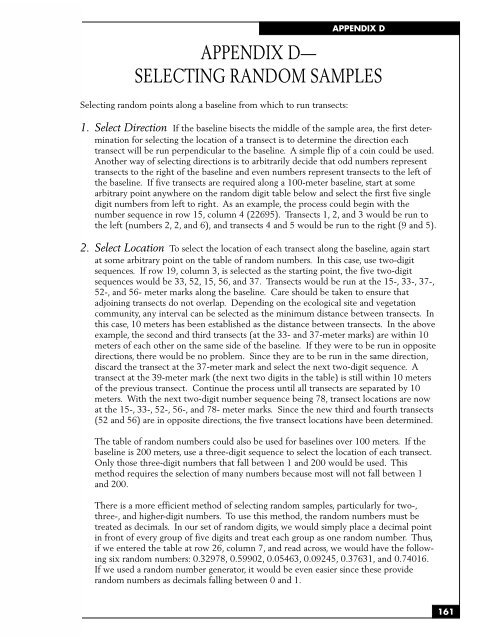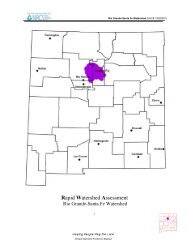SAMPLING VEGETATION ATTRIBUTES - New Mexico NRCS - US ...
SAMPLING VEGETATION ATTRIBUTES - New Mexico NRCS - US ...
SAMPLING VEGETATION ATTRIBUTES - New Mexico NRCS - US ...
You also want an ePaper? Increase the reach of your titles
YUMPU automatically turns print PDFs into web optimized ePapers that Google loves.
APPENDIX D<br />
APPENDIX D—<br />
SELECTING RANDOM SAMPLES<br />
Selecting random points along a baseline from which to run transects:<br />
1. Select Direction If the baseline bisects the middle of the sample area, the first determination<br />
for selecting the location of a transect is to determine the direction each<br />
transect will be run perpendicular to the baseline. A simple flip of a coin could be used.<br />
Another way of selecting directions is to arbitrarily decide that odd numbers represent<br />
transects to the right of the baseline and even numbers represent transects to the left of<br />
the baseline. If five transects are required along a 100-meter baseline, start at some<br />
arbitrary point anywhere on the random digit table below and select the first five single<br />
digit numbers from left to right. As an example, the process could begin with the<br />
number sequence in row 15, column 4 (22695). Transects 1, 2, and 3 would be run to<br />
the left (numbers 2, 2, and 6), and transects 4 and 5 would be run to the right (9 and 5).<br />
2. Select Location To select the location of each transect along the baseline, again start<br />
at some arbitrary point on the table of random numbers. In this case, use two-digit<br />
sequences. If row 19, column 3, is selected as the starting point, the five two-digit<br />
sequences would be 33, 52, 15, 56, and 37. Transects would be run at the 15-, 33-, 37-,<br />
52-, and 56- meter marks along the baseline. Care should be taken to ensure that<br />
adjoining transects do not overlap. Depending on the ecological site and vegetation<br />
community, any interval can be selected as the minimum distance between transects. In<br />
this case, 10 meters has been established as the distance between transects. In the above<br />
example, the second and third transects (at the 33- and 37-meter marks) are within 10<br />
meters of each other on the same side of the baseline. If they were to be run in opposite<br />
directions, there would be no problem. Since they are to be run in the same direction,<br />
discard the transect at the 37-meter mark and select the next two-digit sequence. A<br />
transect at the 39-meter mark (the next two digits in the table) is still within 10 meters<br />
of the previous transect. Continue the process until all transects are separated by 10<br />
meters. With the next two-digit number sequence being 78, transect locations are now<br />
at the 15-, 33-, 52-, 56-, and 78- meter marks. Since the new third and fourth transects<br />
(52 and 56) are in opposite directions, the five transect locations have been determined.<br />
The table of random numbers could also be used for baselines over 100 meters. If the<br />
baseline is 200 meters, use a three-digit sequence to select the location of each transect.<br />
Only those three-digit numbers that fall between 1 and 200 would be used. This<br />
method requires the selection of many numbers because most will not fall between 1<br />
and 200.<br />
There is a more efficient method of selecting random samples, particularly for two-,<br />
three-, and higher-digit numbers. To use this method, the random numbers must be<br />
treated as decimals. In our set of random digits, we would simply place a decimal point<br />
in front of every group of five digits and treat each group as one random number. Thus,<br />
if we entered the table at row 26, column 7, and read across, we would have the following<br />
six random numbers: 0.32978, 0.59902, 0.05463, 0.09245, 0.37631, and 0.74016.<br />
If we used a random number generator, it would be even easier since these provide<br />
random numbers as decimals falling between 0 and 1.<br />
161




